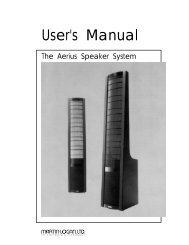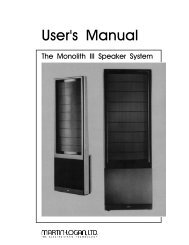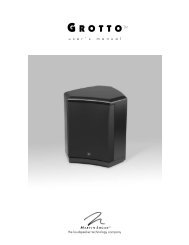Electrostatic historyIn the late 1800’s, any loudspeaker was considered exotic. Today,most of us take the wonders of sound reproduction for granted.beginning to rot, was made of a pig intestine that was coveredwith fine gold leaf to conduct the audio signal.EnglishIt was 1880 before Thomas Edison had invented thefirst phonograph. This was a horn-loaded diaphragmthat was excited by a playback stylus. In 1898, Sir OliverLodge invented a cone loudspeaker, which he referred toas a “bellowing telephone”, that was very similar to the conventionalcone loudspeaker drivers that we know today.However, Lodge had no intention for his device to reproducemusic because in 1898 there was no way to amplify an electricalsignal! As a result, his speaker hadnothing to offer over the acoustical gramophonesof the period. It was not until1906 that Dr. Lee DeForrest inventedthe triode vacuum tube. Before this, anelectrical signal could not be amplified.The loudspeaker, as we know it today,should have ensued then, but it did not.Amazingly, it was almost twenty yearsbefore this would occur.In 1921, the electrically cut phonograph record becamea reality. This method of recording was far superior to themechanically cut record and possessed almost 30 dB of dynamicrange. The acoustical gramophone couldn’t begin to reproduceall of the information on this new disc. As a result, furtherdevelopments in loudspeakers were needed to cope with thisamazing new recording medium.By 1923, the decision was made to develop a complete musicalplayback system consisting of an electronic phonograph and a loudspeakerto take advantage of the new recording medium. Theproject to two young engineers, C. W. Rice and E. W. Kellogg.Rice and Kellogg had a well equipped laboratory at their disposal.This lab possessed a vacuum tube amplifier with an unheardof 200 watts, a large selection of the new electrically cut phonographrecords and a variety of loudspeaker prototypes thathad been collecting over the past decade. Among these wereLodge’s cone, a speaker that used compressed air, a corona discharge(plasma) speaker, and an electrostatic speaker.After a short time, Rice and Kellogg had narrowed the field of“contestants” down to the cone and the electrostat. The outcomewould dictate the way that future generations would referto loudspeakers as being either “conventional” or “exotic”.Rice and Kellogg hadnarrowed the field of“contestants down” to thecone and the electrostat.When Rice and Kellogg began playing the new electricallycut records through the electrostat, they were stunned andimpressed. The electrostat performed splendidly. They hadnever heard instrumental timbres reproduced with such realism.This system sounded like real music rather than the honking,squawking rendition of the acoustic gramophone. Immediately,they knew they were on to something big. The acoustic gramophonewas destined to become obsolete.Due to Rice and Kellogg’s enthusiasm,they devoted a considerable amount oftime researching the electrostatic design.However, they soon encountered the samedifficulties that even present designers face;planar speakers require a very large surfacearea to reproduce the lower frequenciesof the audio spectrum. Because the managementconsidered large speakers unacceptable, Rice andKellogg’s work on electrostatics would never be put to use for acommercial product. Reluctantly, they advised management togo with the cone. For the next 30 years, the electrostatic designlay dormant.During the Great Depression of the 1930’s, consumer audioalmost died. The new electrically amplified loudspeaker nevergained acceptance, as most people continued to use their oldVictrola-style acoustic gramophones. Prior to the end of WorldWar II, consumer audio saw little, if any, progress. However, duringthe late 1940’s, audio experienced a great rebirth. Suddenlythere was tremendous interest in audio products, and with that,a great demand for improved audio components. No sooner hadthe cone become established than it was challenged by productsdeveloped during this new rebirth.In 1947, Arthur Janszen, a young Naval engineer, took part in aresearch project for the Navy. The Navy was interested in developinga better instrument for testing microphone arrays. The testinstrument needed an extremely accurate speaker, but Janszenfound that the cone speakers of the period were too nonlinearin phase and amplitude response to meet his criteria. Janszenbelieved that electrostats were inherently more linear than cones,so he built a model using a thin plastic diaphragm treated with aconductive coating. This model confirmed Janszen’s beliefs, for itexhibited remarkable phase and amplitude linearity.Their electrostat was something to behold. This enormous bipolarspeaker was as big as a door. The diaphragm, which wasJanszen was so excited with the results that he continuedresearch on the electrostatic speaker on his own time. He soon34 Electrostatic History
thought of insulating the stators to prevent the destructive effectsof arcing. By 1952, he had an electrostatic tweeter elementready for commercial production. This new tweeter soon createda sensation among American audio hobbyists. Since Janszen’stweeter element was limited to high frequency reproduction, itoften found itself used in conjunction with woofers—most notably,those from Acoustic Research. These systems were highlyregarded by all audio enthusiasts.As good as these systems were, they would soon be surpassed byanother electrostatic speaker.In 1955, Peter Walker published threearticles regarding electrostatic loudspeakerdesign in Wireless World, a Britishmagazine. In these articles, Walker demonstratedthe benefits of the electrostaticloudspeaker. He explained that electrostaticspermit the use of diaphragms thatare low in mass, large in area and uniformlydriven over their surfaces by electrostatic forces. Dueto these characteristics, electrostats have the inherent ability toproduce a wide bandwidth, flat frequency response with distortionproducts being no greater than the electronics driving them.By 1956, Walker backed up his articles by introducing a consumerproduct, the now famous Quad ESL. This speakerimmediately set a standard of performance for the audio industrydue to its incredible accuracy. However, in actual use, theQuad had a few problems. It could not be played very loud,it had poor bass performance, it presented a difficult load thatsome amplifiers did not like, its dispersion was very directionaland its power handling was limited to around 70 watts. As aresult, many people continued to use box speakers with cones.These developments allowthe consumer to own thehighest performance loudspeakerproducts ever built.speaker product. Other companies soon followed; each withtheir own unique applications of the technology. These includeAcoustat, Audiostatic, Beverage, Dayton Wright, Sound Lab andStax, to name a few.Electrostatic speakers have progressed and prospered becausethey actually do what Peter Walker claimed they would. Thelimitations and problems experienced in the past were notinherent to the electrostatic concept. They were related to theapplications of these concepts.Today, these limitations have beenresolved. Advancements in materialsdue to the U.S. space program givedesigners the ability to harness the superiorityof the electrostatic principle. Today’selectrostats use advanced insulation techniquesor provide protection circuitry.The poor dispersion properties of earlymodels have been addressed by usingdelay lines, acoustical lenses, multiple panel arrays or, as in ourown products, by curving the diaphragm. Power handling andsensitivity have also been increased.These developments allow the consumer the opportunity toown the highest performance loudspeaker products ever built.It’s too bad Rice and Kellogg were never able to see just how farthe technology would be taken.EnglishIn the early 1960’s Arthur Janszen joined forces with the KLH loudspeakercompany, and together they introduced the KLH 9. Due tothe large size of the KLH 9, it did not have as many sonic limitationsas the Quad. The KLH 9 could play markedly louder and lower infrequency than the Quad ESL. Thus a rivalry was born.Janszen continued to develop electrostatic designs. Hewas instrumental in the design of the Koss Model One, theAcoustech and the Dennesen speakers. Roger West, the chiefdesigner of the Janszen Corporation, became the president ofSound Lab. When Janszen Corporation was sold, the RTRloudspeaker company bought half of the production tooling.This tooling was used to make the electrostatic panels for theServostatic, a hybrid electrostatic system that was Infinity’s firstElectrostatic History 35






